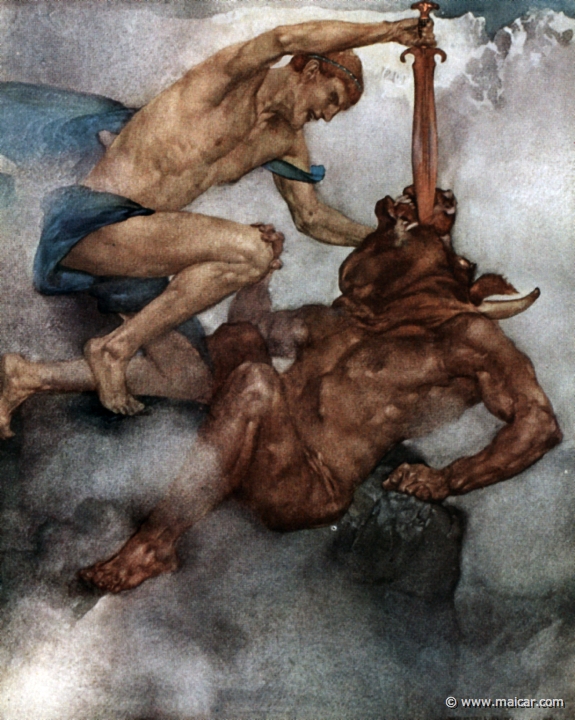|

|
king187: Theseus killing the Minotaur. Painting by William Russell Flint (1880-1969). Charles Kingsley, Grekiska Hjältesagor (1924, Swedish Edition of The Heroes). Paintings (watercolors) from 1911.
|
|
The Minotaur was a bull-headed man, whom King
Minos 2 shut up in the
Labyrinth which
Daedalus had built in
Crete. The Athenians were
then forced by Minos 2 to
send every year seven young men and seven young
women to be fodder of this famous beast.
King Minos 2 upsets
Poseidon
King Minos 2 of
Crete affirmed that he had
received the kingdom from the gods, and in order to
prove it, he declared that whatever he prayed for
would be granted. While sacrificing to
Poseidon, he prayed
that a bull might appear from the sea, and promised
to sacrifice it to the god.
Poseidon sent him such
a beautiful bull, that Minos 2 thought it wiser to sacrifice another bull
instead. In this way, he caused the anger of the
god, who noticing that he had been deluded by the
king, contrived that Minos 2's wife Pasiphae should fall in love with the bull.
Architect at the service of the Queen's
passions
The skilful architect
Daedalus, who, having
been banished from Athens
for murder, lived in
Crete, assisted the queen in satisfying her passion. He constructed a wooden cow on wheels, hollowed it out in the inside, sewed it up in the hide of a cow which he had skinned, and set it in the meadow where the bull used to graze. Then Pasiphae introduced herself into the wooden cow, and so the bull, taking the wooden cow for a real one, came and coupled with her. After some time, Pasiphae gave birth to Asterius 7, a bull-headed man who became known as the Minotaur. It is also told that Pasiphae had not made
offerings to Aphrodite
for several years, that being the reason why the
goddess inspired in her the unnatural love for the
bull. In any case, when Minos 2 discovered the affair, he cast
Daedalus into prison for having used his skill for abnormal purposes, and for having helped to corrupt the queen.
Life of a Minotaur
Minos 2 shut his
monstruous stepson—the bull-headed man—up
in the Labyrinth which also had been built by Daedalus. The Labyrinth
was a chamber whose passageways were so winding
that those unfamiliar with them had difficulty in
making their way out. In this Labyrinth, the
Minotaur was maintained, devouring the youths that
were sent from Athens. The Athenians, having lost a war against
Crete, were forced by
Minos 2 to send every
year seven youths and seven damsels to be fodder of
the Minotaur (but it is also told that
Minos 2 did not destroy
them, but kept them as servants).
Death of the Minotaur
When many young men and women had thus been
destroyed by the Minotaur in the Labyrinth,
Theseus (who later
became king of Athens)
was numbered among those who were sent as the third
tribute to the Minotaur. It was then that
Ariadne, daughter of
Minos 2, fell in love
with Theseus, and
obtaining the secret to the Labyrinth from
Daedalus, disclosed the way out to him. Theseus killed the
Minotaur after finding him in the last part of the
Labyrinth; and with
Ariadne's help, he found
his way out, fled from
Crete, and came to Naxos
with her.
| Family |
|
|
| |
|
 |
|
Some believe that this bull could be
the Marathonian Bull, which killed
Androgeus, son of
Minos 2. The
Marathonian Bull was killed, or mastered,
by Theseus.
Queen Pasiphae, daughter of
Helius, was
immortal, and yet
Aeneas saw her
in the
Underworld.
As her husband consorted with many women,
she bewitched him in such a way that he,
on making love to them, ejaculated beasts,
and his mistresses perished. Some have
said that Pasiphae's mother was Perseis,
one of the
OCEANIDS, but others affirm that her mother was Crete 3 (otherwise unknown).
|
|
|
|
|
|